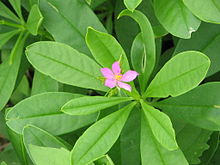Talinum fruticosum (T. triangulare)
Family: Talinaceae
Common names: Leaf Ginseng, Suriname purslane, Water leaf, Philippine spinach, Ceylon spinach, Florida spinach, Potherb Fameflower, Lagos bologi
Medicinal:
Anti-inflammatory
Anti-ulcer
Contraindications:
Avoid in cases of rheumatoid arthritis, kidney stones or gout Edible
Edibility:
Leaves raw or cooked
Raw leaves contain oxalic acid, so eat in moderation, cooking destroys this substance
I have recently planted some new healing herbs in my garden, now that the heat of summer has passed (hopefully). Although, in this subtropical clime, I am using shade umbrellas in the garden to protect my tender little European herbs, as my canopy is not yet complete.
One of the new additions is Leaf Ginseng, which can apparently handle our fierce sun, however I have planted her in a shady spot just in-case. When she sets seed I will scatter some in sunny positions if I can catch them before the seed pods explode!
This pretty little plant resides under my Mango tree, and was just closing up her flowers for the night when I went out to photograph her.
Leaf Ginseng is a perennial in warm climates, but acts as an annual in cooler climates and is a small plant at around 60cm. This slightly succulent herb tolerates neglect. Rich in vitamin C, iron, and calcium, Leaf Ginseng has been eaten as a leaf vegetable in parts of Africa and has a slightly sour, bitter taste due to the oxalic acid content, which disappears once cooked (both the sour taste and the acid).
Leaf Ginseng has been used to treat peptic ulcers in Nigeria, and recent research by Onwurah et al (2013) supports this. This plant has been used in West Africa to treat female sterility, dystocia, fever, skin rash, paludism, anemia, myalgia and hemorrhage. In other parts of the world it has been used to treat measles, cancer, polyuria, and cardiovascular diseases like stroke and obesity. The leaves or the whole plant are the most frequent plant parts used, and they are high in flavonoids, antioxidants and are hepato-protective (great for a healthy liver).
This plant is not the same as true Ginseng in the Panax genus, and they are easy to tell apart.

Leaf Ginseng (Talinum fruticosum)




